Hello lovely hivers,am always happy that I have this kind of moment to discuss important topics relating to human life as I usually anticipate it. I hope we are all good. In my previous post I talked about some vital care rendered to newborn babies specifically the prematured ones and the relevance or roles those type of care play in their lives and I know some of us here learnt somethings and also contributed to the discussion.
Today's topic will focus majorly on reflexes in humans specifically babies both in utero (in the womb) till after birth and I encourage everyone to put on your seat belts as I take us on this smooth ride.
Generally reflexes or reflex action is simply an involuntary (not under your conscious control) response to stimulus which could be either external or internal. By stimuli I mean situations or conditions that causes or brings about the reflex action.
Some of these involuntary actions ( Reflex actions) commence even before the baby is born, I know it might be suprising to you, so I also felt the first time I got to know about it. Also,these reflexes have a length of time or duration in the life of the baby after which it is expected that it disappears. In addition, one of the reflexes reappears during the period of infancy and continues till adulthood.
So this post will take care of just six reflexes in babies out of the several other types and this reflexes includes the: the moro reflex, the rooting reflex, the sucking reflex, the grasping reflex, babinski reflex and the stepping reflex.
Also, the reflexes will be discussed under the subheadings of when they start developing as well as when they end.
Reflexes that develop during the period of pregnancy
• The moro reflex
This moro reflex is some times called the startle reflex by some school of thoughts.
The Moro reflex was first described in western medicine by Austrian pediatrician Ernst Moro (1874–1951) in 1918. Moro referred to it as the Umklammerungsreflex which means the embracing reflex.
This particular reflex is a way through which new borns respond to any frightening situation and then react to gain safty. It usually commences during the period of pregnancy especially in the third trimester when it is well developed. So like I earlier stated some of these reflexes start during pregnancy and terminates before the 1year of their life.
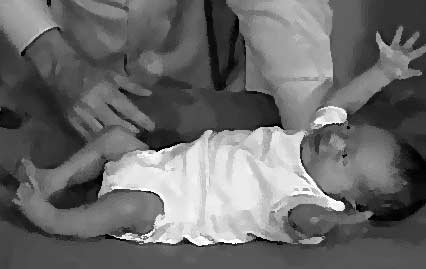
A baby exhibiting moro reflex when startled
Moro reflex is known to terminate by the 6th month latest of the baby's life, and it's usually seen as an abnormality if it still shows after the period of 6months in a baby. It's presence after the period of six months usually implies a neurological dysfunction, which at times are irreversible.
Moro reflex is usually seen when a baby is suddenly frightened as his or her mechanism of withstanding the frightening situation or when startled, and it involves spreading of the arms and legs and withdrawing of the lower limbs as in bending them to the body as though the baby wants to embrace the mother for protection against the unexpected scary condition, as well as backward tilting of the head.
• sucking reflex
This involuntary action is also seen to begin while the baby is still in utero (in the womb) during the third trimester of pregnancy though it still not fully developed untill at 36weeks.
A baby's survival depends on sucking. This skill is so important that babies start practicing long before birth! In utero, it's easy for babies to suck their fingers because the womb's soft walls deflect their hands toward their mouth
Earlier in one of my posts about prematured babies, I mentioned at some point that the preterm babies have immature sucking reflex which makes it difficult for them to establish breastfeeding easily and this is because they have not gotten to term which is the period this reflex develops fully.
To know if the sucking reflex of a baby is matured enough anything that is put in the mouth of the baby, either nipple, finger, water bottle, the baby will grab it with the lips and begin to suck it making it easier for early establishment of breastfeeding. Also this sucking reflex is usually seen when the roof of the mouth is touched or stimulated in a baby.
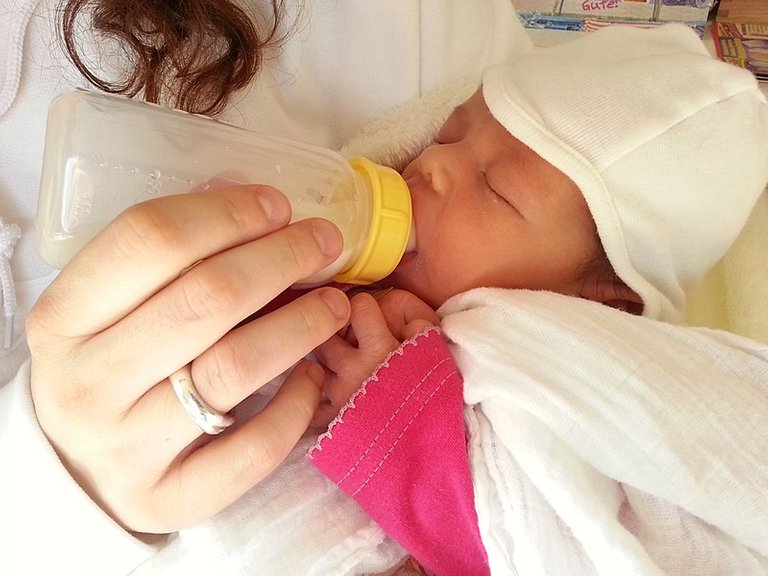
A baby sucking the feeding bottle through the help of the sucking reflex
In preterm babies because this reflex is not well developed, commencement of breastfeeding will be difficult which is why feeding through nasogastric tube is usually adopted as well as kangaroo mother care to help establish breastfeeding.
In addition, sucking reflex most times is a way of pacifying babies to stop them from crying because it's seen that if a crying baby is put to breast or have something put in the mouth, the baby Channels his or her energy to suckling on that there by preventing further cry.
Sucking reflex usually last till the fourth month after birth, after which it disappears. To reemphasize, if this reflexes still exist even after this period, it's a sign of neurological problem in the individual and calls for medical attention.
• Rooting reflex
This involuntary action is usually seen to work hand in hand with the sucking reflex as it comes first or even helps in initiating the sucking process during breastfeeding. This reflex most times could be seen as a sign of hunger in babies.
It develops during the early third trimester of pregnancy, that is why most times its usually not seen in prematured babies or it might not even be well developed for them to make use.
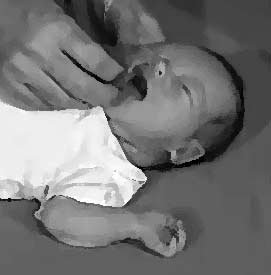
A baby trying to grab with the lips,what touched the conner of the mouth
How does it happen?
This reflex occurs when the side or even any area of the babies mouth or lips is stroked with either hand, an object or even the breast, the baby responds by turning its head with the mouth moving towards the direction of whatsoever that stroked his or lips with intension of grabbing it to suck. This explains my initial comment that both sucking and rooting reflex works together especially during the process of initiating breastfeeding.
Let me also take our minds back a little to one of my post about Kangaroo care, where I said that this method of care helps in promoting breastfeeding. During this period of kangaroo care in which the baby is placed skin to skin with the mother close to the mother's breast, the side of the baby's mouth most times comes in contact with the breast of the mother, and the baby usually is seen following the direction of the breast which is known as the rooting process inorder to suckle on it and that is how breastfeeding is commenced. So rooting and sucking reflex play major role during breastfeeding in babies.
Rooting reflex usually ends at the third or fourth month of the babies life in normal situations after which the baby is able to turn the head to any direction voluntarily to suckle the nipple without searching for it, although it is seen to be present after the fourth month in some abnormal conditions in the babies like the congenital cerebral palsy, which is why it is advised that parents know this and report early enough to the hospital for pediatric attention when they notice this in their babies.
• Grasp reflex
This involuntary action can also be called reflex of the palm because that's where it majorly occurs. Usually, it starts from pregnancy during the second trimester and because it starts during this time, babies born as preterms are usually seen to posses this particular reflex.
Before you start wondering what the grasp reflex looks like, let me explain it. From the name reflexes of the palm, it simply has to do with the way babies folds their fingers tightly towards their palm as if they are holding something that they don't want to give up and because it's an involuntary action, it's beyond beyond their control and so cannot be voluntarily controlled. In some babies it's usually very firm that you find it difficult to even open. It can also be seen when the middle of the palm is touched, during which the baby grabs whatever touched it tightly into a fist.
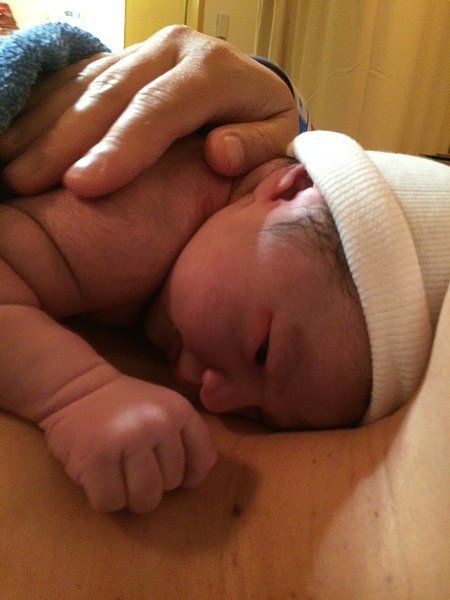
A baby exhibiting the grasp reflex by folding the palm
Do you know the funny aspect of this particular reflex, it starts during pregnancy that is why most babies are seen to hold unto the umbilical cord and in twin pregnancy, one of them may hold on to the leg or body of the other one tightly even during the process of delivery.
When does it end?
Usually the grasp reflex terminates during the sixth month of the babies life after which it's existence after this period indicates neurological disorder during this early years. This grasp reflex can also resurface during the period of adulthood which also is seen to be abnormal and is usually with a cause.
This can occur after an ischemic stroke (a lack of blood flow to the brain) or a hemorrhagic stroke (bleeding in the brain). Both of these destroy brain cells. When the brain is damaged, the palmar reflex may return.
Reflexes that occurs at birth or after birth.
Just as some reflex actions commence during the period of pregnancy, some others start at birth as well as after birth and they include:
• The babinski reflex
This babinski reflex can also be called the reflex of the foot or foot reflex because it occurs in the foot just as the name goes. This babinski reflex is similar to the grasp reflex in babies the only difference here is that the foot reflex involves the foot while the grasp involves the palm. It usually starts at birth and continues till two years of the babies life though in some babies it ends earlier around 12months of their life.
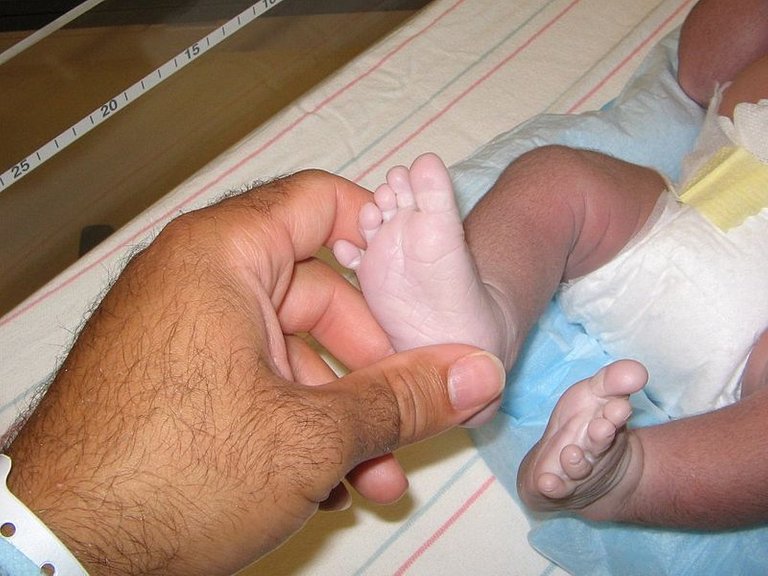
Babinski reflex in a baby when the sole of the feet was stroked
How to test for the reflex
To test or check for this reflex, the sole of the foot is stroke and the baby responds by bending the big toe of the feet upwards towards the top surface of the feet while the other smaller toes spreads as if in a fan shape.
This particular reflex continues till the second month of the baby's life, after which it seizes to be involuntary and subsequently it becomes voluntary which means it's being controlled consciously. This conscious control is also seen in adults but in this case, when the individual's sole is touched or stroked, instead of fanning out there toes as in the case of the babies, all the toes bends or folds downwards together in response to it.
• Stepping reflex
This involuntary action can also be called the walking reflex. Just as the name is, it start at birth and is usually seen when the baby is carried in an upright position as if to stand the baby especially on a hard platform or surface.
Importance
Most times this stepping reflex helps the baby in initiating crawling and walking but with a great deal of support as their limbs are not yet strong enough to carry them,especially when they want to get to where something important is like the mother's breast etc.
Duration
It's known to commence few days after birth in matured babies but the case is usually different for prematured babies in which it starts 2 months after their birth, when they must have become a bit more matured.
This reflex normally ends around the second or third month of the baby's life, and during the period of it's absence, the baby will not be able to step forward when placed in that same position. As the baby grows and gets more matured close to time he or she will commence walking which could be around 10 months or 1year, it reappears because at this point the muscles the baby gained during the period the reflex went into hibernation is strong enough to sustain the baby as he or she starts to step forward gradually.
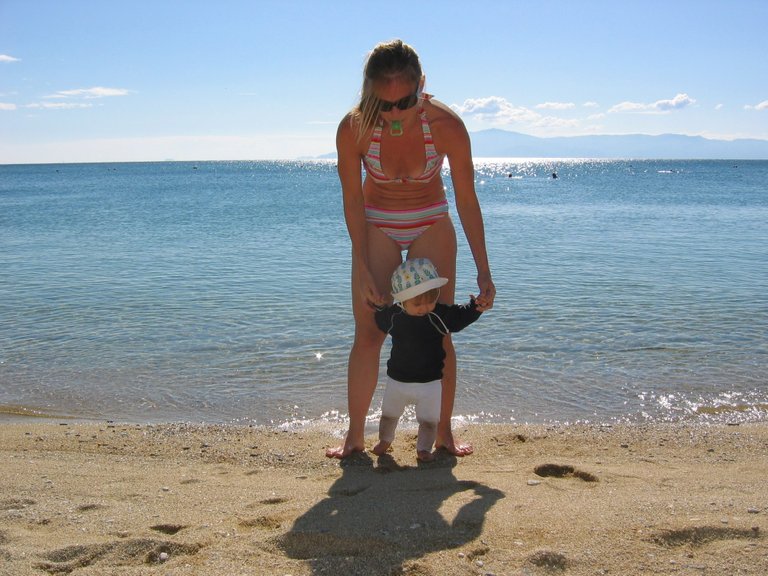
A mother supporting the baby in initiating stepping or walking
The absence of this reflex or over staying of it is usually a sign of neurological deficiency which is mostly seen in neonatal abstinence syndrome as well as cerebral palsy. So prompt medical attention should be week in such situations.
I think I have said much already on this topic, though I didn't discuss all the reflexes as I wanted to due to time, but am glad I was able to talk about major ones. So with all I have discussed, I would love to emphasize on the importance of paying attention to babies so as to identify any unusual trend in the growth milestone especially related to these reflexes and also to seek prompt medical attention especially of a pediatrician.
Am really happy and grateful for your time and patience in going through this article, thanks a bunch as I anticipate your beautiful inputs and support and I hope that this will be helpful too. Stay tuned for more posts.
Reference
• parenting and sucking reflex
Thanks for your contribution to the STEMsocial community. Feel free to join us on discord to get to know the rest of us!
Please consider delegating to the @stemsocial account (85% of the curation rewards are returned).
You may also include @stemsocial as a beneficiary of the rewards of this post to get a stronger support.
Congratulations @nazom! You have completed the following achievement on the Hive blockchain and have been rewarded with new badge(s):
Your next target is to reach 100 upvotes.
Your next target is to reach 2750 upvotes.
You can view your badges on your board and compare yourself to others in the Ranking
If you no longer want to receive notifications, reply to this comment with the word
STOPSupport the HiveBuzz project. Vote for our proposal!